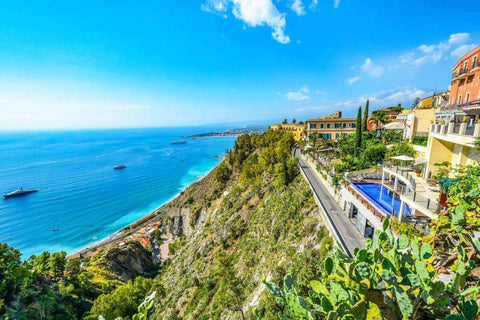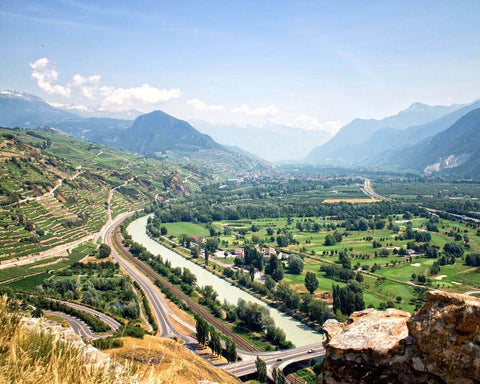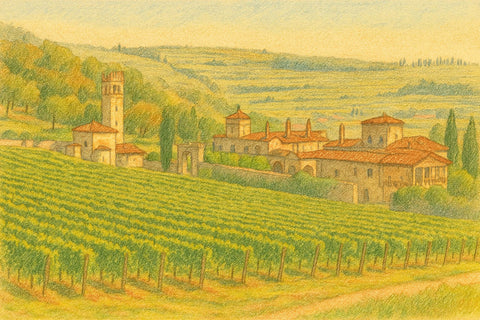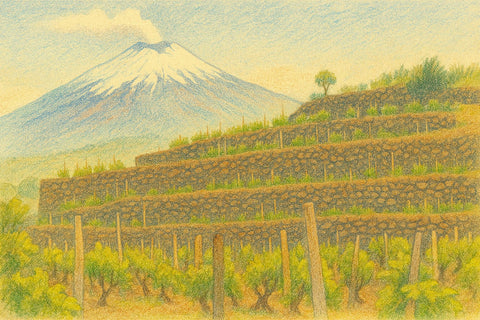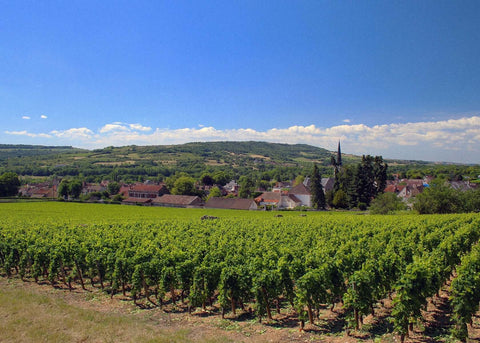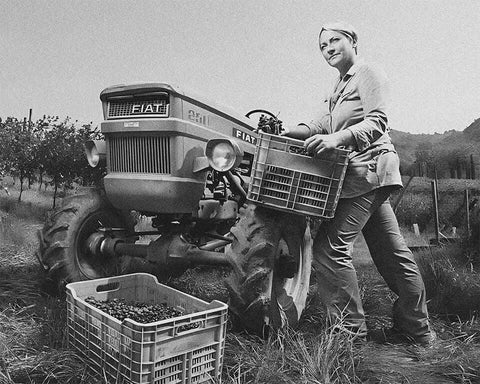Sicily, an island in southern Italy, has a rich history, diverse cultures, and spectacular landscapes. Surrounded by the Mediterranean Sea, Sicily is renowned for its unique blend of natural beauty, architectural wonders, and culinary delights, making it one of Italy's most captivating and storied regions.
Over the centuries, Sicily has evolved into a dynamic and culturally rich region, with a strong emphasis on preserving its historical heritage while embracing modern advancements.
The island's wines, influenced by its varied terroir and climate, are celebrated for their distinctiveness and quality, reflecting the region's enduring dedication to viticulture and oenological excellence.
Table of Contents
History of Sicily
Sicily, strategically positioned in the Mediterranean, has been a crossroads of civilizations for millennia. Its history is a tapestry woven from the influences of ancient Greeks, Romans, Byzantines, Arabs, Normans, and Spanish, each leaving an indelible mark on the island's culture and traditions.
The island's Greek colonization began in the 8th century BCE, marking the start of Sicily's rich cultural heritage. The Greeks founded several cities, including Syracuse and Agrigento, which became centers of learning and culture. These ancient cities flourished, leaving behind impressive ruins and architectural wonders that continue to draw admiration today.
Following the Greeks, the Romans conquered Sicily in the 3rd century BCE, transforming it into a vital province of the Roman Empire. The island played a crucial role as a grain supplier, earning it the nickname "Rome's breadbasket." The Roman period also saw impressive infrastructure development, including roads, aqueducts, and amphitheaters.
The fall of the Roman Empire ushered in a period of Byzantine rule, followed by the Arab conquest in the 9th century. The Arabs introduced advanced agricultural techniques, irrigation systems, and new crops, such as citrus fruits, which thrive in Sicily today. The island's cuisine and architecture were also profoundly influenced by the Arab presence.
In the 11th century, the Normans, led by Roger I, conquered Sicily, bringing a period of prosperity and cultural blending. The Norman kingdom of Sicily became known for its tolerance and cosmopolitanism, where Latin, Greek, and Arabic cultures coexisted harmoniously. This period saw the construction of stunning cathedrals and palaces, such as the Palatine Chapel in Palermo.
The subsequent centuries saw Sicily under various rulers, including the Hohenstaufen, the Angevins, and the Spanish. Each dynasty contributed to the island's rich cultural mosaic, leaving behind architectural marvels and artistic treasures. The Spanish rule, in particular, brought baroque architecture and artistic flourishing to cities like Noto and Ragusa.
The 19th century was a significant change for Sicily. The island played a pivotal role in the Risorgimento, the movement for Italian unification. In 1860, Giuseppe Garibaldi's Expedition of the Thousand landed in Marsala, leading to Sicily's incorporation into the Kingdom of Italy. This period also began Sicily's modern wine industry, with vineyards being replanted and new winemaking techniques introduced.
The 20th century brought both challenges and advancements to Sicily. The island faced economic hardships, but its resilient spirit and cultural richness helped it navigate these difficulties. The post-World War II period saw significant development in infrastructure, tourism, and the wine industry, establishing Sicily as a prominent player on the global stage.
Terroir of Sicily
Sicily's terroir is as diverse as its history, characterized by various microclimates, soil types, and elevations. The island's volcanic origins, particularly from Mount Etna, are crucial in shaping its unique viticultural landscape.
The island enjoys a Mediterranean climate with hot, dry summers and mild, wet winters. This climate, combined with the influence of the surrounding sea, creates ideal conditions for grape cultivation. The coastal areas benefit from cooling sea breezes, while the inland regions experience greater temperature variations, contributing to the complexity of the wines.
The Geology of Sicily
Sicily's geology is marked by its volcanic soil, particularly around Mount Etna, Europe's highest and most active volcano. The volcanic soil is rich in minerals, providing a fertile ground for vines to thrive.
- Mount Etna: The slopes of Mount Etna are known for their black volcanic soils, which impart unique mineral characteristics to the wines. The high-elevation vineyards benefit from cooler temperatures and significant diurnal temperature variation, producing wines with remarkable acidity and structure.
- Western Sicily: This area features limestone and clay soils, ideal for growing a variety of indigenous grape varieties. The coastal influence and warm climate contribute to producing robust and flavorful wines.
- Southern Sicily: The southern part of the island has sandy and calcareous soils, well-suited for the cultivation of Nero d'Avola and other indigenous grapes. The warm, dry climate ensures full ripeness and concentration of flavors.
The diverse terroir of Sicily allows for the cultivation of a wide range of grape varieties, each expressing the unique characteristics of its growing region.
Climate and Its Influence
Sicily's climate is predominantly Mediterranean, characterized by hot summers, mild winters, and moderate rainfall. The island's varied topography and proximity to the sea create numerous microclimates, each contributing to the distinctiveness of Sicilian wines.
The Grapes of Sicily
Sicily is home to several indigenous grape varieties, each adapted to the island's unique terroir. The most notable are Nero d'Avola, Nerello Mascalese, Catarratto, and Grillo.
Red Grape Varietals
- Nero d'Avola: The flagship red grape of Sicily, known for its bold flavors, rich color, and excellent aging potential.
- Nerello Mascalese: Grown primarily on the slopes of Mount Etna, this grape produces elegant, complex wines with high acidity and fine tannins.
- Frappato: Known for its light body, fresh acidity, and aromatic profile, often blended with Nero d'Avola in the Cerasuolo di Vittoria DOCG.
- Perricone: A lesser-known variety producing robust and tannic wines with dark fruit flavors.
White Grape Varietals
- Catarratto: The most widely planted white grape in Sicily, known for its crisp acidity and citrus flavors.
- Grillo: Used in the production of both still and sparkling wines, offering bright acidity and floral aromas.
- Inzolia: Also known as Ansonica, this grape produces fresh and aromatic wines with notes of citrus and herbs.
- Carricante: Predominantly grown on Mount Etna, known for its high acidity and minerality.
Top Wines of Sicily
Nero d'Avola: The quintessential Sicilian red wine, Nero d'Avola is celebrated for its deep color, bold flavors of dark fruit and spices, and excellent aging potential. It is a versatile wine that pairs well with a variety of dishes.
Etna Rosso: Made primarily from Nerello Mascalese, Etna Rosso wines are known for their elegance, complexity, and distinctive minerality, reflecting the volcanic terroir of Mount Etna. These wines offer a unique expression of Sicilian viticulture.
Grillo: A prominent white wine variety in Sicily, Grillo is valued for its bright acidity, floral aromas, and refreshing character. It is used in still and sparkling wines, making it a versatile choice for various occasions.
Other Notable Wines: Sicily also produces a range of other exceptional wines, including Cerasuolo di Vittoria, a blend of Nero d'Avola and Frappato, known for its vibrant fruit flavors and balanced structure. Zibibbo, also known as Muscat of Alexandria, is used to produce aromatic and sweet wines, often in a fortified style.
Cuisine and Typical Products of Sicily
Sicilian cuisine reflects the island's diverse cultural influences and abundant natural resources. The cuisine is renowned for its bold flavors, fresh ingredients, and innovative use of spices and herbs, making it one of Italy's most distinctive regional cuisines.
Seafood plays a central role in Sicilian cooking, with dishes like "Pasta con le Sarde," a pasta dish with fresh sardines, fennel, pine nuts, and raisins, exemplifying the island's culinary creativity. The fertile land also yields various fruits, vegetables, and nuts, integral to many traditional dishes.
Among the island's most prized products are its citrus fruits, blood oranges, and pistachios, especially from Bronte. These ingredients are used in various dishes, from savory to sweet, showcasing the versatility and richness of Sicilian produce.
Sicilian Antipasti
In Sicily, a meal often begins with a selection of antipasti, highlighting the island's diverse flavors. A typical antipasti spread might include:
- Caponata: A sweet and sour eggplant dish with tomatoes, capers, olives, and vinegar, served at room temperature.
- Arancini: Fried rice balls filled with ragù, mozzarella, and peas, often served as a snack or appetizer.
- Panelle: Chickpea flour fritters, often served in a sandwich or with a squeeze of lemon.
- Insalata di Mare: A refreshing seafood salad with octopus, shrimp, and calamari dressed in olive oil and lemon.
Sicilian Primi Piatti (First Courses)
The first course in a Sicilian meal often features pasta, risotto, or hearty soups, showcasing the island's grains and vegetables.
- Pasta alla Norma: A classic Sicilian pasta dish with eggplant, tomatoes, ricotta salata, and basil.
- Busiate al Pesto Trapanese: A traditional pasta from Trapani, served with a pesto made from tomatoes, almonds, garlic, and basil.
- Minestra di Ceci: A chickpea soup with rosemary and garlic, often served with croutons or bread.
- Risotto ai Gamberi e Limone: A risotto with shrimp and lemon, reflecting the island's love for seafood and citrus.
Sicilian Secondi (Second Courses)
Sicilian second courses often highlight the island's abundant seafood and high-quality meats.
- Pesce Spada alla Siciliana: Sicilian-style swordfish cooked with tomatoes, olives, capers, and oregano.
- Involtini di Carne: Beef or veal rolls stuffed with breadcrumbs, cheese, and herbs, then grilled or baked.
- Polpette di Sarde: Sardine meatballs flavored with pine nuts, raisins, and fennel, often served with tomato sauce.
- Coniglio alla Stimpirata: A rabbit dish cooked with a sweet and sour sauce made from vinegar, sugar, capers, and olives.
Sicilian Contorni (Side Dishes)
Sicilian cuisine celebrates vegetables, with many side dishes highlighting the island's produce.
- Peperonata: A dish of slowly cooked bell peppers, onions, and tomatoes, often served at room temperature.
- Frittelle di Fiori di Zucca: Fried zucchini flowers, often stuffed with ricotta or anchovies.
- Insalata Pantesca: A potato salad from the island of Pantelleria made with tomatoes, capers, red onions, and olives.
Sicilian Formaggi (Cheeses)
Sicily produces a variety of cheeses, reflecting the island's agricultural diversity.
- Pecorino Siciliano: A hard sheep's milk cheese with a robust, tangy flavor, often used in cooking or enjoyed on its own.
- Ragusano: A semi-hard cow's milk cheese from the province of Ragusa, known for its mild and slightly sweet flavor.
- Provola dei Nebrodi: A stretched-curd cheese from the Nebrodi Mountains, often smoked and enjoyed for its distinctive taste.
- Ricotta Infornata: Baked ricotta cheese, which develops a firm texture and rich, caramelized flavor.
Sicilian Dolci (Dessert)
Sicilian desserts often feature almonds, citrus fruits, and ricotta cheese, creating a range of sweet treats.
- Cannoli: Crispy pastry tubes filled with sweetened ricotta cheese, often flavored with chocolate chips or candied fruit.
- Cassata: A traditional Sicilian cake made with sponge cake, ricotta cheese, candied fruit, and marzipan.
- Granita: A semi-frozen dessert made from sugar, water, and various flavorings, such as lemon, almond, or coffee.
- Torrone: A nougat made with honey, sugar, and toasted almonds, often enjoyed during festivals and celebrations.
Typical Products of Sicily
Sicily's cuisine is grounded in high-quality local products, many of which have achieved protected status, ensuring their authenticity and traditional production methods.
Citrus Fruits: The Island's Jewels
Sicily is famous for its citrus fruits, particularly blood oranges (Arance Rosse di Sicilia IGP), known for their vibrant color and sweet-tart flavor. These fruits are used in various dishes and beverages, adding a refreshing brightness to Sicilian cuisine.
Pistachios: Bronte's Green Gold
The pistachios from Bronte (Pistacchio Verde di Bronte DOP) are renowned for their intense flavor and bright green color. They are used in savory and sweet dishes, from pasta sauces to pastries.
Olive Oil: Liquid Gold
Sicilian olive oil (Olio Extravergine di Oliva DOP) is celebrated for its fruity and peppery flavor. The island's diverse olive varieties and traditional production methods result in high-quality oils used in cooking and dressing.
Cheese: A Taste of Tradition
Sicily produces a variety of traditional cheeses, each reflecting the characteristics of its production area.
- Canestrato: A hard, aged cheese made from sheep's milk, known for its sharp and tangy flavor.
- Maiorchino: A hard cheese made from sheep's and goat's milk, produced in the province of Messina.
- Tuma Persa: A rare and ancient cheese made from cow's milk with a complex flavor and creamy texture.
More on Sicily's History
- Ancient Foundations
- Greek and Roman Domination
- The Byzantine and Arab Era
- Norman and Spanish Rule
- Unification with Italy
- Sicily in the Modern Age
Ancient Foundations
Sicily, the largest island in the Mediterranean, boasts a rich history that begins in the prehistoric era. The earliest human settlements are traced back to the Upper Paleolithic period. The island's strategic position attracted various ancient peoples, including the Phoenicians and the Greeks. The Greeks established prominent cities such as Syracuse and Agrigento, significantly influencing the island's culture and architecture.
Greek and Roman Domination
The Greek period, starting around the 8th century BCE, saw Sicily become a center of Hellenic civilization. This era is marked by remarkable architectural and cultural achievements. Following the Greeks, Sicily fell under Roman control in the 3rd century BCE. The Roman era was characterized by economic prosperity and further urban development, leaving behind a wealth of archaeological sites.
The Byzantine and Arab Era
After the fall of the Roman Empire, Sicily experienced a period of Byzantine rule, followed by Arab conquest in the 9th century. The Arab period introduced significant agricultural advancements and left a lasting impact on the Sicilian language and cuisine. The island became a melting pot of cultures, evident in its unique architectural styles.
Norman and Spanish Rule
The Norman conquest of Sicily in the 11th century ushered in a new era of prosperity and cultural fusion. Norman rule is celebrated for the coexistence of Christian, Muslim, and Jewish communities. The Spanish domination, beginning in the 13th century, marked a period of economic challenges but also contributed to the rich tapestry of Sicilian culture and art.
Unification with Italy
In 1860, Sicily became part of the newly unified Kingdom of Italy. This period was marked by social and economic upheavals, including the rise of the Mafia. The 20th century saw Sicily grappling with poverty and emigration, yet playing a crucial role in both World Wars and the post-war Italian Republic.
Sicily in the Modern Age
Today, Sicily is a vibrant region with a strong identity, known for its rich history, diverse culture, and stunning landscapes. Its economy is bolstered by agriculture, tourism, and a growing technology sector. Sicily continues to cherish its historical sites, unique cuisine, and a blend of cultural influences that make it a fascinating microcosm of Mediterranean history.
Author: Melissa Norton ©

